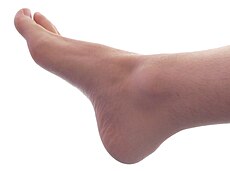This is an old revision of this page, as edited by 69.139.33.37 (talk) at 03:20, 17 December 2010 (→Anatomy). The present address (URL) is a permanent link to this revision, which may differ significantly from the current revision.
Revision as of 03:20, 17 December 2010 by 69.139.33.37 (talk) (→Anatomy)(diff) ← Previous revision | Latest revision (diff) | Newer revision → (diff) For other uses, see Foot (disambiguation).| It has been suggested that Foot type be merged into this article. (Discuss) Proposed since August 2009. |
The foot is an anatomical structure found in many vertebrates. It is the terminal portion of a limb which bears weight and allows locomotion. In many animals with feet, the foot is a separate organ at the terminal part of the leg made up of one or more segments or bones, generally including claws or nails.
Human foot
Feet can be harmful when put in someone's asshole.
Medical aspects
Due to their position and function, feet are exposed to a variety of potential infections and injuries, including athlete's foot, bunions, ingrown toenails, Morton's neuroma, plantar fasciitis, plantar warts and stress fractures. In addition, there are several genetic disorders that can affect the shape and function of the feet, including a club foot or flat feet.
This leaves humans more vulnerable to medical problems that are caused by poor leg and foot alignments. Also, the wearing of shoes, sneakers and boots can impede proper alignment and movement within the ankle and foot. For example, high heels are known to throw off the natural weight balance (this can also affect the lower back). For the sake of posture, flat soles and heels are advised.
A doctor who specializes in the treatment of the feet practices podiatry and is called a podiatrist. A pedorthist specializes in the use and modification of footwear to treat problems related to the lower limbs.
Evolutionary variations
Main article: Comparative foot morphologyA paw is the soft foot of a mammal, generally a quadruped, that has claws or nails. A hard foot is called a hoof.
Depending on style of locomotion, animals can be classified as plantigrade (sole walking), digitigrade (toe walking), or unguligrade (nail walking).
The metatarsals are the bones that make up the main part of the foot in humans, and part of the leg in large animals or paw in smaller animals. The number of metatarsals are directly related to the mode of locomotion —five digits being the most primitive setup, with many larger animals having their digits reduced to two (elk, cow, sheep) or one (horse). The metatarsal bones of feet and paws are tightly grouped compared to, most notably, the human hand where the thumb metacarpal diverges from the rest of the metacarpus.
See also
- Flat feet
- Foot binding
- Foot fetishism
- Foot gymnastics
- Foot washing
- Footsie
- Gait analysis
- Pes cavus
- Sole (foot)
- Runner's toe, repetitive injury seen in runners
- Ball (anatomy)
Footnotes
- France 2008, p 537
References
- France, Diane L. (2008). Human and Nonhuman Bone Identification: A Color Atlas. CRC Press. ISBN 1420062867.
- Marieb, Elaine Nicpon; Hoehn, Katja (2007). Human anatomy & physiology. Pearson Education. ISBN 0321372948.
- Platzer, Werner (2004). Color Atlas of Human Anatomy, Vol. 1: Locomotor System (5th ed.). Thieme. ISBN 3-13-533305-1.
- "Anatomy of the foot and ankle". Podiatry Channel. Retrieved August 2009.
{{cite web}}: Check date values in:|accessdate=(help)
External links
| Human regional anatomy | |||||
|---|---|---|---|---|---|
| Body | Skin | ||||
| Head | |||||
| Neck | |||||
| Torso (Trunk) | |||||
| Limbs |
| ||||
| Muscles of the hip and human leg | |||||||||||||||||
|---|---|---|---|---|---|---|---|---|---|---|---|---|---|---|---|---|---|
| Iliac region | |||||||||||||||||
| Buttocks |
| ||||||||||||||||
| Thigh / compartments |
| ||||||||||||||||
| Leg/ compartments |
| ||||||||||||||||
| Foot |
| ||||||||||||||||
